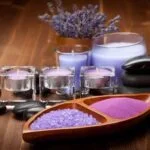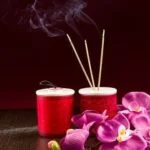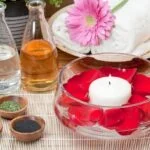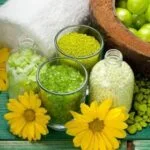Spa aromatherapy blends have become increasingly popular in the wellness industry, offering a natural and holistic approach to relaxation and healing. The use of essential oils in spa treatments is not only soothing to the senses but also offers a range of therapeutic benefits for the mind, body, and emotions.
This article will provide an overview of spa aromatherapy blends, explaining the science behind aromatherapy, highlighting popular essential oils used in spa blends, sharing tips for creating a home spa experience, customizing blends for different needs, and exploring their role in holistic wellness.
Aromatherapy is based on the science of how essential oils interact with our sense of smell and their impact on our overall well-being. Different scents can evoke specific emotional or physiological responses, making them a powerful tool for relaxation and mood enhancement. Whether diffused into the air, applied to the skin during massages or added to bath soaks, spa aromatherapy blends offer versatile ways to experience their benefits.
With the growing interest in natural wellness practices and self-care rituals, it’s no surprise that spa aromatherapy blends are becoming beloved staples in both professional spa treatments and at-home relaxation routines. In this article, we will delve into the various aspects of using aromatherapy for holistic wellness, including its integration into professional spa treatments and providing simple DIY recipes for creating your own spa-quality aromatherapy blends at home.
The Science Behind Aromatherapy
How Essential Oils Work in Aromatherapy
Aromatherapy is the practice of using essential oils to promote holistic healing, relaxation, and overall well-being. The science behind aromatherapy lies in the powerful properties of essential oils, which are derived from various plants, flowers, herbs, and fruits.
When these essential oils are inhaled or applied to the skin, they interact with the body’s olfactory system and are believed to have a direct impact on the brain and nervous system. This interaction can lead to a range of therapeutic effects, including stress relief, improved sleep, pain reduction, and mood enhancement.
The Impact of Different Scents
Each essential oil has its own unique chemical composition and aroma profile that contributes to its specific therapeutic benefits. For example, lavender essential oil is known for its calming and sedative properties, making it an ideal choice for relaxation and sleep enhancement.
On the other hand, citrus essential oils like lemon and sweet orange are often used to uplift the mood and increase mental alertness. By understanding how different scents affect the mind, body, and emotions, spa practitioners can create custom blends tailored to their clients’ specific needs.
Benefits of Aromatherapy
The use of aromatherapy in a spa setting is not only about creating a pleasant sensory experience but also about providing real therapeutic benefits. Research has shown that certain essential oils have anti-inflammatory, antimicrobial, and analgesic properties that can aid in healing processes.
Additionally, aromatherapy has been found to reduce anxiety levels and improve overall emotional well-being. Understanding the science behind how essential oils work in aromatherapy allows spa professionals to harness the full potential of these natural remedies for their clients’ health and relaxation needs.
Popular Essential Oils Used in Spa Aromatherapy Blends
When it comes to spa aromatherapy blends, essential oils play a crucial role in providing relaxation and healing benefits. These are the most commonly used essential oils in spa blends:
- Lavender: Known for its calming and soothing properties, lavender essential oil is often used to promote relaxation and improve sleep quality.
- Peppermint: With its invigorating and refreshing scent, peppermint essential oil is commonly used for its energizing effects and to relieve muscle tension.
- Chamomile: This gentle and comforting essential oil is favored for its ability to reduce stress and anxiety while promoting a sense of peace and tranquility.
Each of these essential oils possesses unique benefits for the mind, body, and emotions. Lavender helps to ease tension and promote restful sleep, while peppermint offers an uplifting sensation that can help with mental clarity and focus. Chamomile brings a sense of calmness and relaxation, making it effective for stress relief.
Spa aromatherapy blends often combine these essential oils to create well-rounded experiences that cater to different wellness needs. Whether it’s a massage oil infused with lavender, or a diffuser blend featuring chamomile and peppermint, these popular essential oils are versatile additions to any spa aromatherapy treatment.
It is important to note that each individual’s response to essential oils may vary, so it’s best to experiment with different blends to find what works best for each person’s personal preferences and needs.
How to Use Spa Aromatherapy Blends
Spa aromatherapy blends are a wonderful way to take the benefits of essential oils and bring them into your daily life. There are various methods for using these blends, each offering unique advantages for your well-being.
Methods of Use
One of the most popular ways to use spa aromatherapy blends is through the use of diffusers. These devices disperse the essential oil particles into the air, allowing you to breathe in the therapeutic scents. Another method is through massage oils, where the blend can be applied directly to the skin and absorbed during a relaxing massage. Additionally, adding a few drops of blended essential oils into a bath soak can create a soothing and rejuvenating experience.
Creating a Home Spa Experience
Bringing spa aromatherapy blends into your home is easier than ever. By incorporating these blends into your daily routine, you can enhance relaxation and promote wellness. One tip for creating a home spa experience with aromatherapy blends is to designate a dedicated space for relaxation, such as a cozy corner with soft lighting and comfortable seating. You can also use aromatherapy blends during meditation or yoga practice to elevate mindfulness and deepen relaxation.
Tips for Use
It’s important to note that when using spa aromatherapy blends, it’s best to dilute them with carrier oils before applying them directly to the skin, as some essential oils may cause irritation when used undiluted. Additionally, when using diffusers, be mindful of pets in the household as certain essential oils can be harmful if ingested by animals. Lastly, always follow usage guidelines and safety precautions provided with each essential oil product.
By incorporating spa aromatherapy blends into your daily routine, you can enjoy their many benefits while creating a calming and nurturing environment at home. Whether it’s through diffusers, massage oils, or bath soaks, there are endless possibilities for bringing these delightful scents and their healing properties into your everyday life.
Customizing Aromatherapy Blends for Different Needs
Aromatherapy blends can be customized to address specific wellness needs, such as stress relief, sleep enhancement, and mood elevation. By combining different essential oils, individuals can create personalized blends to target their unique concerns and goals. Here are some tips for tailoring spa aromatherapy blends for different needs:
- Stress Relief: Some of the best essential oils for stress relief include lavender, chamomile, and bergamot. These scents have calming properties that can help to reduce feelings of anxiety and promote relaxation. Blending these oils together can create a powerful formula for combatting stress and tension.
- Sleep Enhancement: For those struggling with insomnia or restless sleep, essential oils like cedarwood, ylang-ylang, and valerian root can be beneficial. These soothing scents are known for their sedative effects, which can help to promote a more restful night’s sleep when used in a bedtime aromatherapy blend.
- Mood Elevation: To uplift the mood and improve emotional well-being, citrus essential oils like lemon, orange, and grapefruit are excellent choices. These energizing scents can provide a much-needed boost during times of low energy or mood swings.
Creating personalized spa aromatherapy blends allows individuals to harness the power of scent to support their overall health and wellness. Whether it’s managing stress, improving sleep quality, or enhancing mood, customized aromatherapy blends offer a natural and holistic approach to meeting specific well-being needs.
By experimenting with different combinations of essential oils and adjusting the ratios based on individual preferences, individuals can fine-tune their own signature aroma that resonates with them on a personal level. Whether used at home or incorporated into professional spa treatments, customized aromatherapy blends offer a versatile tool for supporting overall wellness goals.
The Role of Spa Aromatherapy in Holistic Wellness
Aromatherapy has long been recognized for its therapeutic benefits, and its role in holistic wellness has become increasingly prominent in the spa industry. The use of spa aromatherapy blends is rooted in the belief that essential oils derived from plants can have a positive impact on an individual’s physical, emotional, and spiritual well-being. As a result, many spas are incorporating aromatherapy into their treatment offerings to provide a more comprehensive and holistic approach to wellness.
One of the key aspects of spa aromatherapy in holistic wellness is its ability to complement other spa treatments and practices. Combining aromatherapy with massage therapy, yoga, meditation, and other holistic modalities can create a synergistic effect that enhances the overall spa experience. The use of specific essential oils during massages or facials can promote relaxation, relieve stress, and uplift the mood, contributing to a more profound sense of well-being for spa-goers.
Beyond its physical benefits, spa aromatherapy also plays a crucial role in addressing spiritual and emotional needs. Certain scents, such as lavender for relaxation or peppermint for mental clarity, are believed to have an impact on one’s emotional state. Incorporating these scents into the spa environment can create a calming and uplifting atmosphere that nurtures inner peace and balance for guests seeking a holistic wellness experience.
In essence, incorporating spa aromatherapy into overall holistic wellness practices offers individuals a multifaceted approach to self-care. By integrating essential oils into various spa treatments and creating an environment that stimulates the senses, spas aim to provide guests with a deeply relaxing and rejuvenating experience that addresses their physical, emotional, and spiritual well-being.
| Benefits | Impact |
|---|---|
| Physical relaxation | Relieves stress |
| Emotional balance | Uplifts the mood |
| Spiritual nurturing | Promotes inner peace |
Professional Spa Aromatherapy Treatments
Aromatherapy has been a staple in the spa industry for years, and professional spa treatments have taken advantage of the benefits of spa aromatherapy blends. These blends are skillfully crafted to create a sensory experience that enhances the overall spa treatment. Whether it’s through massages, facials, or body wraps, aromatherapy adds an extra layer of relaxation and healing to the spa experience.
In professional spa settings, essential oils are often used in conjunction with massage therapy to promote relaxation, improve mood, and alleviate stress. The use of specific essential oils can complement the therapeutic effects of massages by targeting different areas of wellness. For example, lavender essential oil is commonly used for its calming properties, making it a popular choice for relaxation-focused treatments.
Facials also benefit from the integration of aroma therapy blends. The scents of essential oils can enhance the overall sensory experience during a facial treatment. Certain essential oils are known for their skin-healing properties or ability to tone and rejuvenate the skin, making them valuable additions to professional facial services.
Spas also incorporate aromatherapy into body wrap treatments. These wraps often involve applying a mixture of therapeutic ingredients onto the skin before wrapping the body in cloth or plastic. Aromatherapy blends are added to these mixtures to create a holistic experience that not only nourishes the skin but also relaxes and uplifts the mind and spirit.
Overall, professional spa treatments harness the power of spa aromatherapy blends to provide clients with an immersive and rejuvenating experience that extends beyond merely physical relaxation but also caters to emotional well-being.
| Professional Spa Treatment | Aromatherapy Blend Used |
|---|---|
| Massage Therapy | Lavender essential oil for relaxation |
| Facial Treatments | Chamomile essential oil for skin soothing and healing |
| Body Wraps | Peppermint essential oil for energizing and invigorating effect |
DIY Spa Aromatherapy Blends for Home Use
Spa aromatherapy blends are a beautiful way to bring the benefits of aromatherapy into your own home. By creating your own blends, you have the freedom to experiment and tailor the scents to your personal preferences and wellness needs.
Using essential oils in this way can help to enhance relaxation, promote better sleep, and uplift your mood. Whether you want to create a spa-like atmosphere during a relaxing bath or boost your energy levels with a revitalizing diffuser blend, DIY spa aromatherapy blends offer endless possibilities for self-care.
When making your own spa aromatherapy blends, it’s important to start with high-quality essential oils. Look for pure, therapeutic-grade oils that are free from synthetic additives. This ensures that you’re getting the true benefits of each oil’s unique properties.
Additionally, consider investing in some basic blending tools such as amber glass bottles for storage and dropper caps for precise measurements. Properly storing your blends away from heat and sunlight will help maintain their potency over time.
As you begin to experiment with creating your own spa aromatherapy blends, remember that there is no right or wrong way to do it. Trust your instincts and let your creativity guide you as you discover the scents that resonate most with you.
Whether you’re blending for relaxation, stress relief, or simply to enjoy delightful fragrances in your space, the process of creating custom spa aromatherapy blends can be a deeply satisfying and rewarding part of your wellness routine. Plus, by making them yourself, you’ll know exactly what goes into each blend – giving you peace of mind about the purity and quality of the ingredients used in enhancing your well-being.
Frequently Asked Questions
What Essential Oil Blend Smells Like the Spa?
The essential oil blend that smells like the spa typically includes calming and soothing scents such as lavender, eucalyptus, peppermint, and chamomile. These fragrances help create a relaxing and refreshing atmosphere reminiscent of a spa.
What Aromatherapy Oils Do Spas Use?
Spas often use a variety of aromatherapy oils to create different experiences for their clients. Some common aromatherapy oils used in spas include lavender for relaxation, eucalyptus for clearing sinuses, peppermint for invigoration, and rosemary for mental clarity.
What Scent Is Used at Most Spas?
The scent used at most spas is often a combination of calming and refreshing fragrances such as lavender, eucalyptus, and peppermint. These scents are commonly associated with relaxation, stress relief, and rejuvenation – all of which contribute to the overall spa experience.

Are you looking for a natural way to improve your health and wellbeing?
If so, aromatherapy may be the answer for you.





